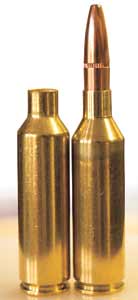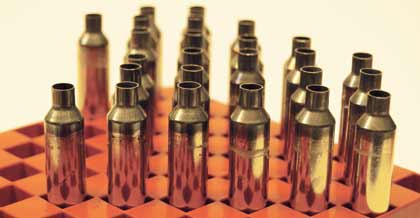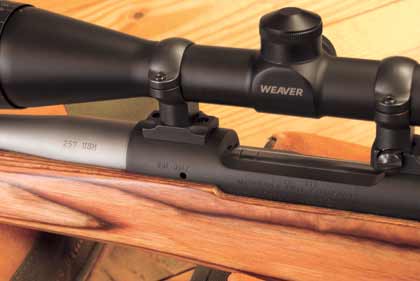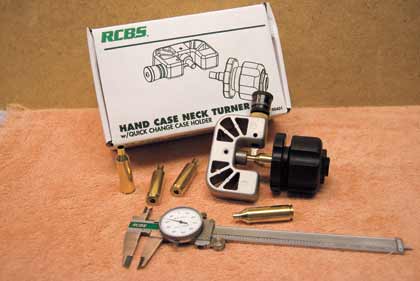January 04, 2011
By Lane Pearce
By Lane Pearce
 The final fireformed .257 USM wildcat case starts as a .270 WSM factory case and is then annealed, resized, trimmed, and neck-turned. |
Sometimes I get involved in a shooting project that can't be considered to be remotely practical. It's happened again. I've been working up loads for my latest wildcat rifle cartridge, the .257 USM. Yes, as the moniker suggests, it's .25 caliber, but no, the "U" is not an abbreviation for "ultimate." USM actually stands for "unimproved short magnum."
The idea for this wildcat started when Winchester and Browning invited several writers on a caribou hunt in northern Alaska about three years ago. The bush pilot ferried us about 30 miles north of Kotzebue to a base camp situated along the Squirrel River in the Baird Mountains.
Advertisement
We couldn't hunt the same day we flew into camp, so we were just settling in and getting acquainted with each other. The conversation veered to what the next WSM and WSSM cartridges would be. A veteran hunter/writer asked, "What happened to the .257 WSM?"
The company rep replied that although it had been on the to-do list, the higher pay grades declared the proposed round as ballistically untenable and decreed the .25 WSSM as a better option. Our host was so disturbed by the decision that he went ahead and ordered a custom rifle chambered for a necked-down .270 WSM.
Advertisement
I later purchased a couple Model 70s in .25 WSSM after deciding it was the best of the three super-short magnums. Performance mirrors the .25-06, but the compact WSSM package is much handier. I also have a Weatherby Vanguard Sub-MOA chambered in .257 Weatherby Magnum. Cartridge efficiency is definitely an oxymoron for this round because, with the heavier bullets, you have to load half again more propellant compared to the .25 WSSM to achieve, at most, 15 percent greater velocity.
A couple years later, I read a glowing review of the wildcat .25 Pronghorn, the necked-down .270 WSM round we'd discussed on that earlier caribou hunt. It sounded like an interesting project; however, the more I considered it, the more I thought that integrating the two Winchester factory rounds might even be a better idea. So overlaying the neck and shoulder of the .25 WSSM on the full-size .270 WSM case formed the .257 USM.
I essentially just un-improved the already overbore-capacity round.
Surely, wildcatting a wildcat can't be practical.
To make matters even more impractical, I decided to build a rifle from scratch instead of simply rebarreling a factory model already chambered for one of the short-magnum cartridges.
I had a reamer cut that altered the front end of the .270 WSM chamber dimensions to those of the .25 WSSM. The shoulder starts about fifty thousandths of an inch farther back. So the neck is a bit longer, and the shoulder angle is also less abrupt--30 instead of 35 degrees.
Next, I chose a Montana Rifle Co. Model 1999 medium-length (3.100 inches) action instead of short or standard length so that I could seat the heaviest .25-caliber bullets no deeper than to the base of the case neck. Gunsmith John Gallagher blued the action; fitted a stainless, 26-inch, Lilja barrel (three-groove, 1:8-inch twist); and bedded the barreled action in a take-off laminated Winchester Model 70 Coyote stock.
RCBS supplied a custom set of Gold Medal bushing dies to complement my custom chamber specifications. I hoped to avoid annealing the parent .270 WSM brass, so I reformed a few cases and made up dummy rounds for Gallagher to use to headspace the barrel. Several months later when he completed the project, I noticed one of the dummy rounds exhibited stress-corrosion cracks. I definitely had to anneal the cases before reforming them.
 Successful annealing is shown by melted indicating fluid and uniform bluish discoloration of the case necks and shoulders. |
 Lane's custom .257 USM rifle combines a Montana Rifle Co. Model 1999 action, a Lilja barrel, and a take-off laminated stock from a Winchester Model 70 Coyote. |
The Annealing Process
Fortunately, Hornady had recently sent me a handy annealing kit. It has three different-sized case-holding/rotating fixtures and a bottle of temperature-indicating fluid. Together, they assure you can evenly heat your cases without applying excessive heat to them.
It's simple to use. You select which tool best accommodates the case body, i.e., it fits freely and the neck and shoulder extend at least an inch or so out of the mouth. Then, you apply the fluid around each case approximately 1/4 inch below the shoulder and let it dry.
Next, you chuck the tool shank in a variable-speed drill and set it at the slowest speed. Before lighting the propane torch, securely mount the fuel bottle and orient the nozzle a foot or so above an open container partially filled with water. Hold the spinning case neck within the flame tip and watch the brass change color from a straw gold to a bluish tint as the case rotates. Don't let the flame flow over the case body. Keep it above the shoulder.
When the annealed zone reaches the shoulder, the indicating fluid will quickly melt. You immediately shake the case into the water bath to stop the annealing process. You never want the discoloration to progress more than 1/4 inch past the shoulder or the neck to glow reddish. If either condition occurs, the case has been structurally damaged and must be discarded. Of course, you should dry the cases completely before reloading them.
Additional Case Prep
While reforming the annealed brass, I determined after sizing several cases that I needed to neck the diameter down in two steps to assure the brass flowed evenly. That's easily accomplished by using an intermediate-diameter bushing. I trimmed 20 cases to uniform length and assembled a box of handloads for fireforming.
After firing them, I measured the expanded case necks and concluded I should outside neck-turn them to achieve uniform thickness and to ensure there would be adequate clearance and expansion in the custom chamber.
So far, I've reloaded this batch four times with three different bullets and two propellants. Initial results look promising, and I'm sure this will become a season-long project. I'm not going to report the exact recipe(s) I tested since I can't measure pressures to be sure they are absolutely safe. However, they all passed the bolt-lift and shiny-case-head, ejector-mark criteria. Velocities ranged from 3,100 to 3,350 fps with 115- and 120-grain bullets seated out to in excess of 3 inches OAL. That's comparable to my .257 Wby's performance, but I'm loading about 10 percent less propellant.
There is one clear indicator I've found that alerts me to detecting excessive pressures. I use a hand tool so I can feel the force required to seat each primer. If it feels similar to previous loading sessions, then it's probably still on the safe side. If the primer loosely seats in the pocket, then the case has surely been abused, and the whole batch should be discarded. Not every brand/type of Large Rifle primer will seat with the same effort, so be sure to use the same primers when using this method to compare how much force is required to seat them.
If this occurs, I back off a couple grains and try again. I've found that maximum loads do not typically deliver optimum accuracy. Longer case life and better accuracy are both practical objectives, even if you're handloading a wildcat cartridge.
 Neck turning may be required if custom chamber dimensions are tight or if reformed case necks are not uniform thickness within 0.001 inch. |
